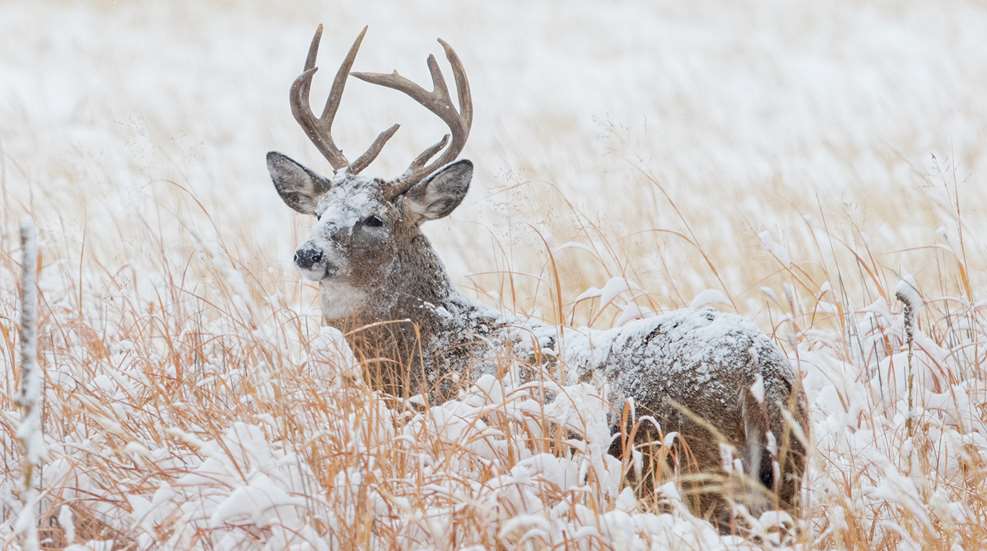
As whitetails slipped from the forest security of the southeastern Iowa farm country I hunted, the females eyed every buck entering the field suspiciously. Why would they not? Even though the November rut was in the rearview, bucks still assessed the female feeding squads for any last breeding opportunities. I guy can hope, right?
Afternoon temperatures were tolerable in the 40s and a far cry from a horrific Iowa hunt I had experienced several years prior. Snow blanketed the landscape then and temperatures never reached above 10 degrees. Blizzard-like conditions forced deer to forget about any meager breeding opportunities and focus on acquiring calories for survival. The conditions—closed roads, a whiteout—even shocked a Great Plains veteran like me. Every layer of clothing possible did not even come close to taming the conditions to tolerable.
That is Iowa and nearly all compass points north when you weigh a late-season muzzleloader hunt. Many muzzleloader seasons kick off just as the rut decelerates. December and ensuing hunts require more than the hotrod actions of bucks juiced up on testosterone. They require a plan. For my late-season hunts in Iowa, all plans include ways to succeed in extreme conditions. Now, as my Iowa hunt unfolded, “extreme” was taking another avenue instead of a North Pole hunt. It was not sunscreen weather, but the moderate temperatures meant an extreme change in the behavior of mature deer.
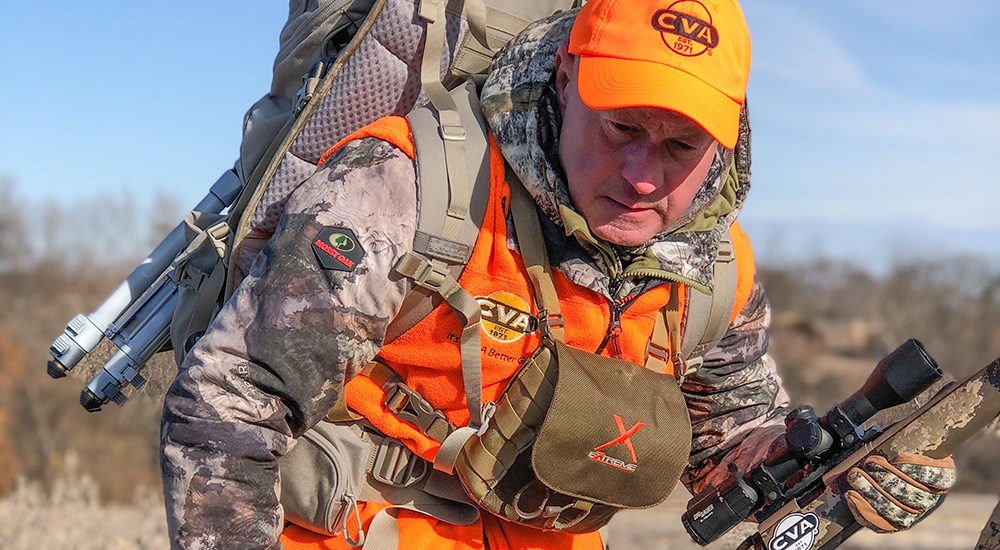
When you apply for most late-season tags, such as in Iowa, you do it in the comfort of air conditioning. That was the case when my friend Chad Schearer, director of media relations and marketing for CVA, urged me to apply for an Iowa muzzleloader tag. He had a connection via Brenton and Rachel Clark of Iowa Whitetail Outfitters if we drew, and I keenly wanted to hunt with my CVA Paramount Pro muzzleloader.
After reading “successful” on emailed draw results, the hunt was planned and I hit the range with earnest. Topping my .45 caliber with a SIG Sauer SIERRA6BDX 3-18x44 riflescope, I soon had the muzzleloader dialed in with “as advertised” accuracy. With groups averaging less than 1.5 inches at 100 and several at less than an inch, I felt that even a 300-yard cross-cornfield shot was doable. December could not arrive soon enough for me—or anyone under five thinking of the impending Christmas festivities.
Despite the profound confidence in my rifle, experiences from past muzzleloader hunts still haunted me. A trustworthy shooting iron aided in alleviating some fears, but the extremes of Iowa lived rent free in my mind whenever anticipation of the hunt sprang to mind.
Extreme Food
Iowa and agriculture are as interconnected as Florida and retirees. You just think of corn when your think of Iowa—and for good reason. According to the U.S. Department of Agriculture, Iowa had more than 13 million acres of farmland planted in corn and nearly another 10 million acres hosting soybeans in 2021. Do not forget that Iowa also means hay production with more than 1 million acres in dry hayfields. Other crops also prosper in the land of Ashton Kutcher and John Wayne. Even the 180,000 acres of oat production can wreak havoc on a hunt after harvest with its volunteer growth attraction.
Iowa differs little from other Midwest locales. Agriculture reigns in the heartland, and that can make huge a impact on your late-season hunt. After the rut, whitetails, especially bucks, need to replenish a body wasted on obsessive procreation activities. This becomes more critical in latitudes experiencing true winter like Iowa, due to temperature and snowfall. Knowing this, whitetails seek out the best nutrition to energize themselves, with corn and soybeans topping the charts.
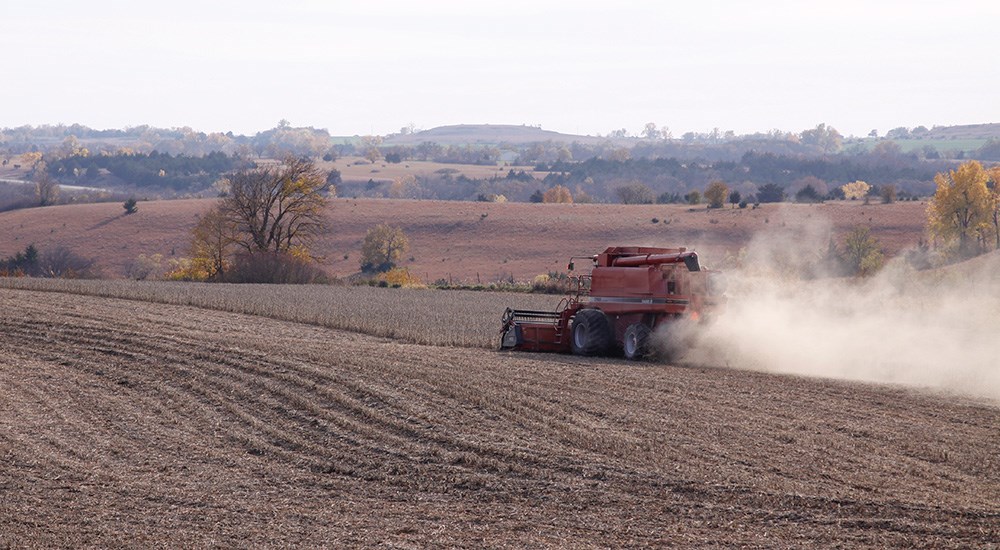
In today’s technological revolution, modern farming equipment leaves little residual grain lying around. Even so, mechanical failures and old equipment occasionally sprinkle crops on the ground. Climatic conditions delaying harvest or leading to crop failure also could leave crops stranded. These gifts are quickly noticed by whitetails for plunder. Deer will move miles in the late season, depending on the conditions, to partake of the best nutrition. Your food plot may appear wonderous, but a standing cornfield represents high-energy corn, plus concealment. Be prepared to improvise.
Several years ago, I held a late-season muzzleloader tag in Iowa and my friend promised his food plots would produce deer sightings. They did not. After two days of dismal sits, I skipped hunting to drive around the area looking for any congregations of deer. On the second night a trip south answered the disappearing deer question. A quarter section of standing corn next to a timbered river valley magnetized the masses. From a hilltop I could look down into the corn to view deer slipping in between rows looking for the next cob to attack. As luck goes, the farmer had already promised hunting permission to another party of hunters, and my tag went unfilled that Iowa season.
Now I always investigate the food options, especially as the hunt nears and a weather forecast begins to emerge. For this hunt in Iowa, I felt confident. The Clarks owned the farms we would hunt, knew the surrounding farming practices and left some crops standing to provide a constant attraction going into the late season.
Extreme Weather
How Iowa’s grocery store of ag goodies is used by whitetails has close ties to weather. Regardless of a Jim Cantore primetime weather event, whitetails will feed as they replenish spent calories. How does weather play into the dining pattern? When weather moderates to a normal or above normal pattern, deer can acquire the calories they need by binging under the cover of darkness. Adolescent deer and some veteran does may dine during daylight, but on pressured properties expect bucks to feed in a Dracula lifestyle. On a past Iowa hunt, I remember driving across the country to reach my hunting location with the AC on. Needless to say, I did not tag a buck that year because mature bucks did not need to expose themselves because of the temperate climate.
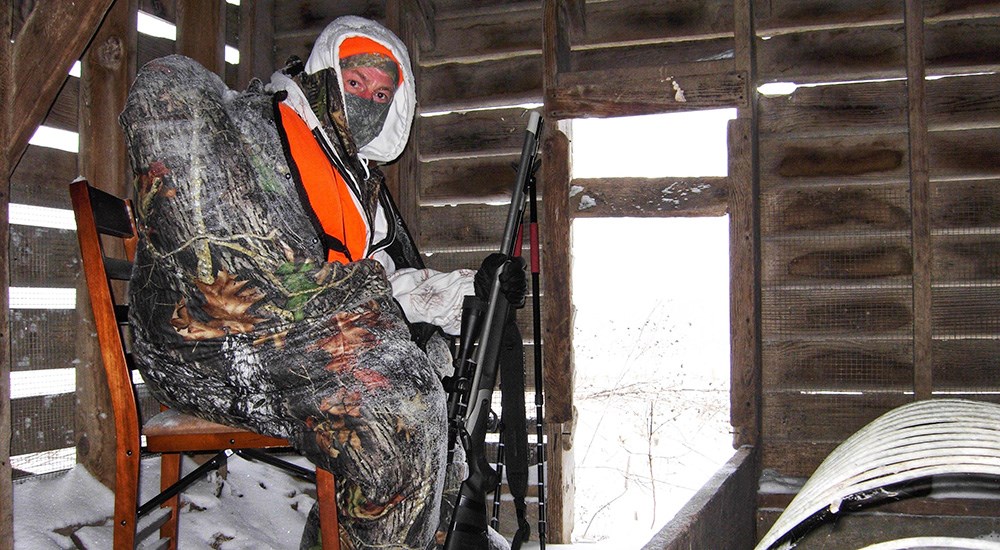 In Iowa’s late season, you should be prepared for cold weather. During one hunt in subzero temps, Kayser hunkered in an old granary in a Heater Body Suit.
In Iowa’s late season, you should be prepared for cold weather. During one hunt in subzero temps, Kayser hunkered in an old granary in a Heater Body Suit.
On another hunt the opposite rang true. I barely made it to our farmhouse outpost before highways started closing due to snow, extreme winds and low visibility. Feet of snow drifted fields into white wastelands. Temperatures plummeted below zero and windchills hit minus 30. Even getting within muzzleloader range of deer proved nearly impossible with county roads drifted shut, feet of snow hampering hiking and deer bunched up by the dozens with eyeballs looking everywhere. To survive, I used a dilapidated outbuilding as a blind and crawled into a Heater Body Suit. The building was situated in the middle of a picked cornfield that deer plowed through knee-deep snow to reach a soybean blown free beyond. On the fourth day a tall-tined 4x4 passed at 120 yards and my CVA ended a miserably successful hunt.
Keep this in mind: December Iowa temperatures average highs of 32 and lows of 18. Overall, December is a dry month with approximately an inch of moisture falling in the state. Expect a mix of sun and clouds. January drops a bit with temperatures averaging close to 28 and lows near 12. Precipitation rises a bit with variables from an inch to 1.5 inches in eastern portions. Although these temperatures may sound temperate for someone from the North Country, I can attest as a Northerner it is the humidity that makes Iowa feel frigid, with an average humidity near 80 percent. And an inch of rain sounds harmless, but look at those temperatures. One inch equals 10 to 12 inches of snow depending on climatic conditions at the time. It can get deep fast.
Extreme Iowa Behavior
The wild swings in whitetail behavior in the late season drive me batty. Iowa has the market cornered on crazy whitetail behavior swings. Hunting pressure drives much of the moodiness, but as outlined above, give a big thank you to weather and a pantry of provisions that rarely looks like empty store shelves today.
Just prior to the long drive to Iowa, I called up the forecast on my HuntStand hunting app. Although the proactive land management scheme of Iowa Whitetail Outfitters bumped my confidence, the above-normal temperatures tamped them back to reality. I had hunted Iowa enough to know that cold and crappy could trump bluebird weather any day. Of course, it is what it is, and I arrived ready to put my best boot forward. Chad and I were the two newbies in the group. Outfitter Brenton Clark showed me an overview of the bucks captured on trail cameras for the farms I would be hunting. One was an unmistakable moose-paddle giant that would not be mistaken. Several others rose above 160 points, and I had no doubt management by the Clarks held top priority.
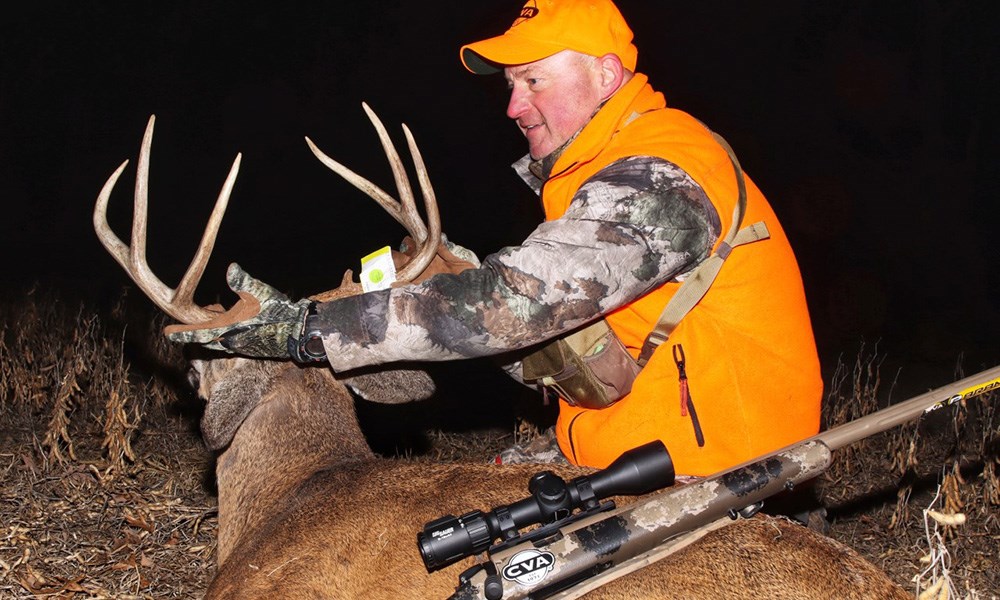 Kayser is used to dealing with extremes in Iowa, whether it’s bundling up in subzero temps, or, as he did last year, above, hunting in shirtsleeve weather.
Kayser is used to dealing with extremes in Iowa, whether it’s bundling up in subzero temps, or, as he did last year, above, hunting in shirtsleeve weather.
The Clarks only hunt afternoons to avoid educating deer that might be feeding in the dark on their fields. That strategy is becoming more common across whitetail country, and I had no issues as it allowed me to catch up on work after a long fall of being in the field. The next evening, I believed in their strategy even more as half the camp lit their charges with unbelievable success. Four mature bucks fell that evening and another the next day, leaving only a handful of hunters, including me and Chad, without a solid sighting yet.
The weather offered no help; it continued to be nice during the hunt. About 90 percent of Iowans appreciated that, but not the handful of us hoping a cold snap would parade bucks to the soybeans. The short December season sped by quickly, and as the last evening of the season arrived I still had not seen a mature buck. I was directed to a huge soybean field; it was mostly picked, but long tilled arms extended into pockets of timber. At the end of each arm were unharvested beans and a shooting house. The unharvested beans acted as the lure and the shooting house provided unequaled invisibility while hunting the field. I knew it was a solid DraftKings bet the field would fill with deer, but given the nice afternoon I wondered whether bucks would join them before dark.

I was correct on the gathering of deer, but from the cues I received from adolescent bucks, no remaining does were in heat. As last light slipped behind the tangle of oaks and elms, I spotted a trio of bucks entering from a far corner. Doing the math, I figured I had 20 minutes for them to make it into shooting range. My math was correct. With only minutes of shooting light left, the widest of the trio rose above a terrace, busily feeding on soybeans. My KILO3000 spit out 150 yards and with the buck closing, I knew trajectory was not an issue. The cloud of smoke from the CVA charge cleared quickly as the buck tumbled backward in a heap of soon-to-be cherished venison.
Iowa never disappoints, even when I do not fill a tag. Nevertheless, despite the extremes found in the Hawkeye State, this time a cornfed buck was the reward.
Create Glimmers of Hope
Late season typically identifies as a rutless period of hunting. Never say never, though. Most whitetail data suggest that from December into January and beyond, 10 percent or slightly more of the female population goes unbred. Much of the excitement sparks from a very few fawns coming into estrus for the first time, but the occasional mature doe could also arrive late to the estrus party. Never look a gift doe in the mouth.
With a 10 percent chance you could score a front-row seat to an after-rut party, you should remain prepared. First, take along your deer calls. A subtle grunt or bleat could be the difference to staring at a buck 100 yards away behind a screen of timber or coaxing it into an open muzzleloader shot. Rattling during your set could draw an unseen buck from an adjacent coulee.
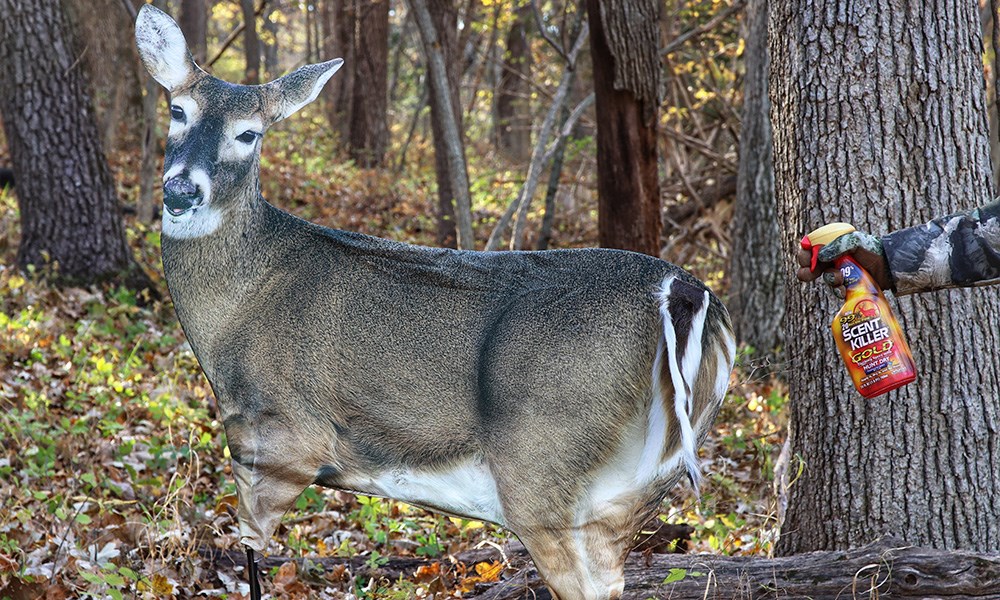
Next, waft some perfume while you wait. Misting a product like Wildlife Research Center’s Golden Estrus or hanging a soaked wick in a shooting lane creates the scent illusion of date-night action. If you find yourself hunting along a trail, a dripper overhanging a mock scrape also makes sense as an attractant, plus distraction when it comes time to make smoke.
Lastly, consider placing a decoy near your ambush point. Decoys can be dangerous during a firearm season so deploy at your own discretion and never set up in the line of fire of a decoy staked out. Montana Decoy manufactures a bevy of whitetail decoys including the Estrus Betty or Trixie doe whitetail decoy. Either one folds up to tuck neatly into your backpack and out of sight. Full-sized decoys, on the other hand, often must be hauled in and out with the appearance of a deer moving. Be sure to wear plenty of orange as you unfold, deploy and take down the decoy.



































